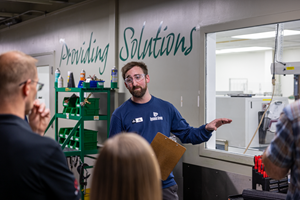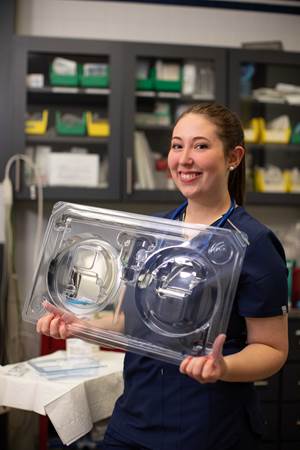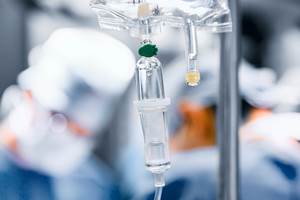Euro Crisis Hovers Over Medical Forecast
Wood on Plastics
Our outlook for U.S. output of medical equipment and supplies in 2012 calls for a gain of 5%. This follows an expansion of just a little less than 5% in 2011.
Our outlook for U.S. output of medical equipment and supplies in 2012 calls for a gain of 5%. This follows an expansion of just a little less than 5% in 2011. This forecast is based on our expectations for a steadily improving U.S. economy during the next couple of years, and also the long-term trend of an aging U.S. population.
As the accompanying chart illustrates, there is a three- to four-year cyclical pattern in the growth trend for this industry. We expect the growth rate to hit its next cyclical peak in the middle of 2012 and then decelerate in the latter months of this year. This does not mean that output levels will actually decline, but rather the rate of growth will moderate compared with the previous year.
The chart shows a couple of other trends that bear mentioning. First, the rate of growth in the medical equipment sector hardly ever goes negative. The annual average increase for the past decade or so has been over 4%. This is well above the annual growth rate for most other types of consumer products and it is also stronger than the overall rate of expansion in the total U.S. industrial sector.
The second thing to notice is that the growth trend in this industry is clearly cyclical, but the cycle does not correspond to the normal business or industrial cycles in the U.S. This is primarily due to a combination of several factors:
•These products tend to be tightly regulated by the Federal government;
•The industry is significantly driven by advances in technology;
•These products are in most cases paid for by third parties (insurance companies or Medicare and Medicaid). Therefore, it is not a true capitalist market.
Looking ahead, there are some unusual circumstances for 2012 to which suppliers to this industry must pay heed. Of immediate concern is the current recession in Europe. The European Union (EU) is a huge importer of American-made medical products, but Europe is at present struggling with a financial crisis.
Another situation that is on the horizon for suppliers of medical equipment is the rapidly changing regulatory environment in the U.S. Starting in 2013, medical device manufacturers will have to pay an excise tax of 2.3% on all medical devices sold here. This is mandated by President Obama’s new healthcare plan. Opponents of this legislation have vowed to repeal it, but this is entirely dependent on the outcome of the fall elections.
Another regulatory change is the effort by the FDA toward greater transparency about where and how medical supplies, devices, parts, materials, etc. are manufactured. This will increase the amount of documentation (red tape) involved for all suppliers to this industry, and this will no doubt raise the cost of doing business.
Yet despite the additional regulatory burdens, one thing remains certain—it may be expensive to make good medical equipment, but it is even more costly to make bad equipment.
WHAT THIS MEANS TO YOU
•A trend towards increased “biomimicry” will garner greater attention in the medical industry. This means processors and OEMs will be working to design products that are more “natural” in both their function and their disposal.
•A recurring theme in the debate on cost reimbursement from Medicare and other insurance providers will focus on medical devices that have high upfront costs but save money over the lifetime of the user. If those are the kinds of products you make, keep making them.
•Low-cost suppliers will be supplanted by suppliers that can offer higher accountability. Processors will be accountable for not only their clean rooms, but also the clean rooms of their material suppliers
Related Content
Medical Molder, Moldmaker Embraces Continuous Improvement
True to the adjective in its name, Dynamic Group has been characterized by constant change, activity and progress over its nearly five decades as a medical molder and moldmaker.
Read MoreCollaboration will bring Recycled Plastic to Medical Device Packaging
Agreement between Eastman and Ethicon will put copolyester derived from recycled materials in sterile barrier applications.
Read MoreSeaway Plastics Acquired
Private equity firm ICG purchased the injection molder and its three facilities located in Florida and California.
Read MoreUse Cavity Pressure Measurement to Simplify GMP-Compliant Medical Molding
Cavity-pressure monitoring describes precisely what’s taking place inside the mold, providing a transparent view of the conditions under which a part is created and ensuring conformance with GMP and ISO 13485 in medical injection molding.
Read MoreRead Next
People 4.0 – How to Get Buy-In from Your Staff for Industry 4.0 Systems
Implementing a production monitoring system as the foundation of a ‘smart factory’ is about integrating people with new technology as much as it is about integrating machines and computers. Here are tips from a company that has gone through the process.
Read MoreProcessor Turns to AI to Help Keep Machines Humming
At captive processor McConkey, a new generation of artificial intelligence models, highlighted by ChatGPT, is helping it wade through the shortage of skilled labor and keep its production lines churning out good parts.
Read MoreHow Polymer Melts in Single-Screw Extruders
Understanding how polymer melts in a single-screw extruder could help you optimize your screw design to eliminate defect-causing solid polymer fragments.
Read More






















